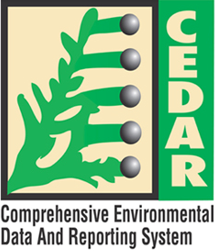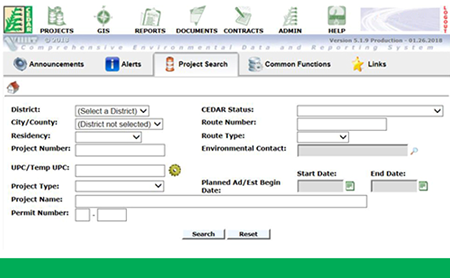
CEDAR
Helps States Increase Process Efficiencies in Project Development
to Improve Environmental Compliance

CEDAR is an internal web app for managing environmental data. (Image courtesy of
VDOT)
The Comprehensive Environmental Data and Reporting system (CEDAR) is an environmental data management system that provides transportation agencies with a single, centralized, source of environmental data, including early screening based on the available environmental data, document management, task tracking, and the identification and management of commitments. Developed by the Virginia Department of Transportation (VDOT) and utilized by several other States, CEDAR is designed to solve common problems in project development and implementation, such as multiple data locations, inconsistencies in processes across projects and divisions, and challenges to intra-agency coordination. VDOT designed CEDAR to be transferable and has been implemented by several other States to manage their environmental data, including Alaska most recently.
Benefits of CEDAR
States implementing CEDAR have reported many benefits, including:
- Economic savings through reduced labor hours resulting from system efficiencies
- Improved compliance with, and application of, environmental laws and regulations
- Enhanced environmental commitment tracking
- Improved communication throughout the agency and with Federal Highway Administration (FHWA)
- Improved confidence with State and Federal agency partners
- Consistent workflow and process delivery
- Enhanced documentation of environmental decisions
- Improved audit process (data and documents are readily available)
- Easy access to project information
- Record retention consistency
Developed as an internal web application, CEDAR provides a single user interface for practitioners to access all of an agency’s environmental data. CEDAR stores information that may have previously been stored across disparate databases, like National Environmental Policy Act (NEPA) documentation, permitting information, and environmental contracts. The database synchronizes nightly with agency databases and operates on a project-by-project basis, allowing users to document, communicate, and track decisions throughout the life of a project. CEDAR also synchronizes with VDOT’s internal Geographic Information Systems (GIS) tool that captures a spatial inventory of project geographies. The GIS tool is used to identify potential impacts a project may have on nearby environmental resources.
As a single repository for traditionally disparate data, CEDAR encourages consistency in processes related to environmental projects, such as reporting, document management, and audits. This in turn has led to economic savings through reduced labor hours, improved compliance, and increased interagency coordination and relationship building.
VDOT Developed CEDAR with Users in Mind
VDOT deployed CEDAR in 2003 to streamline agency workflow for environmental review of transportation projects. Prior to developing CEDAR, VDOT’s Environmental Division relied on 73 different databases spread throughout the Division. With the implementation of CEDAR, VDOT employees were able to use a single database to access all data relevant to a project. In 2008, VDOT updated CEDAR to support electronic handling of contracts and invoices, expanding the systems capabilities as a document management tool. Angel Deem, VDOT’s Environmental Division Director, was involved in CEDAR’s initial development and attributes the application’s long-term success to the active involvement of environmental users in developing requirements and testing functionality. For additional information on the initial development of CEDAR, view this case study on FHWA’s Environmental Review Toolkit.

CEDAR features a single user interface for all of VDOT’s data entry.
(Image courtesy of VDOT)
VDOT is now undertaking additional updates to CEDAR, with support from State Planning and Research (SP&R) Funds. FHWA administers SP&R Funds to assist States with establishing a cooperative, continuous, and comprehensive framework for making transportation investment decisions. The SP&R Funds also help States carry out transportation research activities. VDOT used the SP&R Funds to cover staffing costs for development efforts to keep CEDAR’s technology up-to-date. SP&R Funds also support the CEDAR advisory committees. Made up of practitioners from Virginia, CEDAR advisory committees inform what enhancements are needed to the CEDAR system. The advisory committees have also played a large role in the statewide adoption of the system. The committees gathered feedback across the State to help create a system that met each district’s needs.
CEDAR Can Be Used for Many Types of Projects
VDOT uses CEDAR in many ways, on many different types of projects, including:
Accelerated Project Development: VDOT uses CEDAR to accelerate project development by creating efficiencies in the project development process. Practitioners from divisions across VDOT can quickly reference CEDAR’s centralized database, which has connections to the agency’s GIS and Integrated Project Management systems. CEDAR provides practitioners with an easy way to learn key project information, including its funding source, delivery schedule, and permit requirements. CEDAR also allows users to see potential impacts within a project area by looking at maps and aerial photos. CEDAR provides a centralized location to manage environmental activities and track task completion while also identifying causes of project delay.
Centralized Reporting: CEDAR streamlines required program reporting to other agencies. Prior to the implementation of CEDAR, each of the districts manually maintained a list of reviewed projects and forwarded lists monthly to the Central Office for statewide compilation. Previously, a reporting process that may have taken two days is now accomplished within a few hours. The centralized reporting provides a comprehensive database to identify streamlining and process improvement opportunities.
Streamlined Regional Air Quality Assessment: CEDAR has helped VDOT streamline the process of assessing the impact a project may have on regional air quality. Staff check the appropriate boxes in CEDAR to account for the potential impacts associated with Carbon Monoxide (CO), fine particulate matter (PM2.5) and Mobile Source Air Toxics (MSAT). CEDAR allows VDOT to complete and attach a qualitative MSAT analysis as part of the air quality clearance documentation, and if needed, note whether CO impacts are adequately covered.
Improved Workflow: Additionally, VDOT is using CEDAR to streamline workflows across a variety of tasks, including:
- Scoping projects for noise impacts and maintaining a statewide inventory of barrier assets;
- Streamlining clearance of projects for air quality by addressing regional conformity implications;
- Systematizing the cultural resource review process;
- Accelerating review of Section 106 effect determinations;
- E-Invoicing and document management of contracts, task orders, and invoices;
- Streamlining clearances for Programmatic Categorical Exclusion projects, meeting specified criteria, through systematic task completion and environmental clearances; and
- Tracking and documenting accountability for compliance with environmental commitments.
According to VDOT’s CEDAR administrator, Allison Wishon, VDOT is constantly maintaining the system to be as up-to-date as possible.
VDOT Updates CEDAR to Meet Evolving Agency Needs and Environmental Regulations
VDOT is continually enhancing CEDAR to ensure that the system stays current and continues to support staff needs as environmental regulations change. The agency is developing two new modules scheduled for release in 2019 and 2020.
Facility Compliance Module: The new module will centralize reporting that was previously spread across multiple databases, and allow users to capture inspection data through a mobile app while they are onsite conducting an inspection. It will also include a training console.
Chesapeake Bay Total Maximum Daily Load (TMDL) Module: The Environmental Protection Agency established the Chesapeake Bay TMDL in 2010 to set watershed limits by district with the goal of restoring clean water in the Chesapeake Bay. The plan called for district-by-district practices to be in place to meet certain pollution reduction targets. Districts must meet 100% of their pollution reductions by 2025. The CEDAR TMDL module will allow VDOT to track compliance across districts.
CEDAR Is a Transferable System that States Can Adopt
CEDAR has garnered interest from many other States looking to improve their management of environmental data. The Alaska Department of Transportation and Public Facilities (ADOT&PF) researched systems to streamline their environmental documentation and reporting processes, but no off-the-shelf systems met their needs. Following a demonstration of CEDAR at a Categorical Exclusions Peer Exchange a few years ago, ADOT&PF contacted VDOT to inquire whether the system would work for ADOT&PF. Since CEDAR is a module-based system, it is possible to customize it for any agency’s requirements.
ADOT&PF anticipates that their customized CEDAR application will result in many of the same benefits that VDOT has seen. Existing ADOT&PF environmental documentation and reporting methods rely on manual data entry using Microsoft Word document forms and a Microsoft Access reporting database. This process is open to data entry error and inconsistencies, which could be compounded if environmental laws and regulations change and require new or updated forms and documentation. CEDAR will enable ADOT&PF to streamline their documentation and reporting processes, and keep up-to-date as environmental laws and regulations evolve. CEDAR will also help to streamline Alaska’s additional reporting responsibilities, as a 23 U.S.C. 327 NEPA Full Program Assignment State.
Through the implementation of CEDAR, ADOT&PF looks forward to establishing a more efficient environmental document development and reporting processes.
Contact Information
Mack Frost
Planning and Environmental Specialist
Federal Highway Administration
Virginia Division
(804) 775-3352
Mack.Frost@dot.gov
Allison Wishon
Environmental Data Analyst
Virginia Department of Transportation
(804) 517-3690
Allison.Wishon@vdot.virginia.gov
Look What’s New!
- FHWA and the Federal Transit Administration (FTA) jointly conducted three webinars to inform FHWA and FTA project sponsors and Federal/State resource agency partners of the changes to 23
CFR
771 (Environmental Impacts and Related Procedures) and 23 CFR 774 (Parks, Recreation Areas, Wildlife and Waterfowl Refuges, and Historic Sites (Section 4(f)). Recordings of the webinars can be viewed here.
Successes in Stewardship is a Federal Highway Administration newsletter highlighting current environmental streamlining and stewardship practices from around the country. Click here to subscribe, or call (617) 494-2013 for more information.

